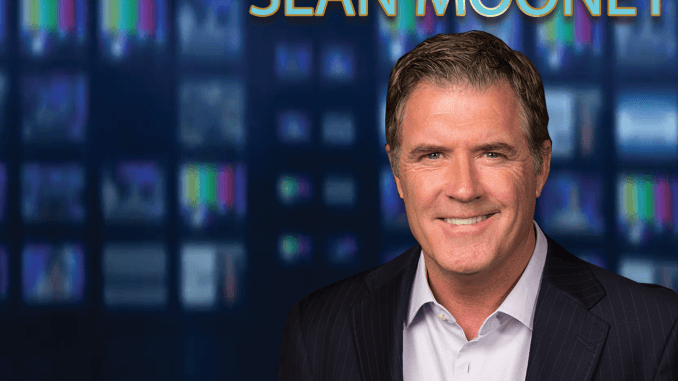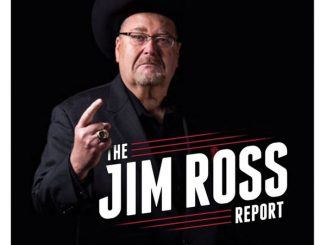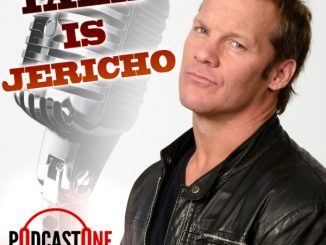
Show Name: Prime Time with Sean Mooney
Episode Title: Episode 19: Bruce Prichard
Release Date: 10/25/2017
Guest: Bruce Prichard
Recap by: Evan Polisher
DIRECT LINK TO LISTEN/DOWNLOAD
Episode Highlights
- Hacksaw Jim Duggan decides to step away from the Prime Time podcast
- Sean will continue with the podcast, bringing in weekly guests from the Golden Age of professional wrestling, the 1980s and 1990s
- Sean’s first guest is Bruce Prichard from the critically acclaimed podcast, Something to Wrestle
- Bruce gets his start in the wrestling business in 1973 at the age of 10, selling posters for Paul Boesch
- Bruce is first introduced to Vince McMahon by wrestler and friend, Eddie Gilbert
- Bruce is fired for the first time from the WWE in 1991, eventually returning 15 months later
- Bruce admits he was difficult to work with during his initial run with the company, but returns a much more humble person
- Not everyone within the company is comfortable with the Brother Love character at first
- Bruce is proud of his overall body of work in the wrestling industry and appreciates the business just as much today as he did during his time with the WWE.
Introduction (0:41)
We start off this week’s episode with some breaking news! Prime Time with Hacksaw Jim Duggan and Sean Mooney…is now Prime Time with Sean Mooney? That’s right, after 18 episodes, Hacksaw has made the difficult decision to step away from the podcast.
Sean is quick to point out that this decision was not a result of any falling out between him and Jim, but rather due to Jim’s jam-packed work schedule and wanting to spend more time with family when he’s not on the road. These commitments made it increasingly difficult to schedule and record podcasts on a weekly basis.
That’s the bad news. The good news? Prime Time will continue on, with featured guests from the ‘Golden Age’ of professional wrestling, the 1980 and 1990’s. Each week, Sean will welcome past WWE performers and key behind-the-scenes contributors.
Sean assures listeners that this will not be the typical wrestling podcast. No shoot interviews here. Rather, the new format for the show will focus on who these wrestling personalities really are, how they broke into the business, and their lives outside of the squared circle.
Plug Time (6:50)
Sean encourages listeners to:
- Follow him on Twitter @SeanMooneyWho and the show @Primetimemlw
- Email the show at primetime@mlw.com
- Pick up a t-shirt at Pro Wrestling Tees (he’ll even give you a call!)
- Leave a review for the show on iTunes (for a chance to win a signed DVD by Sean himself!)
Interview with Bruce Prichard (9:33)
What a way to kick-off the new format of the show, as Sean introduces his very first guest to the show – none other than the “King of Podcasts” himself, Something to Wrestle’s, Bruce Prichard!
Sean and Bruce discuss the meteoric and unexpected rise of the Something to Wrestle podcast, culminated by winning the Academy of Podcasters Award for Best Sports/Recreation Podcast of the Year.
Breaking into the Wrestling Business (13:55)
From an early age, Bruce and his brother, Tom Prichard, loved wrestling and did whatever they could to be a part of the business.
Long before being a part of WWE and becoming an award-winning podcaster, Bruce got his start in the wrestling business in 1973 at the age of 10 – selling posters at the Sam Houston Coliseum for promoter, Paul Boesch. By age 12, Bruce was handling duties as assistant director of television for the promotion. At age 14, when the regular ring announcer could not make it to the venue due to a storm, Bruce quickly seized the opportunity…well sort of, as he asked fans to please rise for the singing of our “natural” anthem.
The Road to the WWE (19:33)
Several years later, when wrestler and friend, Eddie Gilbert, was heading to New York to meet with Vince McMahon, Bruce told him to mention his name and see if there was anything up there for him. Eddie came back from the meeting with Vince’s phone number and a directive to give Vince a call. After numerous attempts, Bruce finally got through to Vince, who told him there was an opportunity for him, but it would require him to move up from Texas to Stamford, CT. The only problem? Bruce had no idea where Connecticut was or how to get there!
Bruce did eventually find his way up north, knowing that this was the place to be if he was ever going to make a true impact in the business. When he got there, Bruce did not have a clearly defined role, helping out in a variety of areas. Soon though, an opportunity would present itself in the form of heading up production, which Bruce would quickly seize.
Sean’s Road to the WWE (29:40)
A quick sidebar on Sean’s own path to the WWE. Bruce happened to come across a tape of Sean, who had been covering sports at the time. With Gene Okerlund burning out quickly at the time and Vince looking for a younger personality, Sean was a natural fit. And the rest, as they say, is history.
Not the Right Fit (37:07)
Sean and Bruce discuss producers who came in over the years who were poor fits for WWE and unsuited for the wrestling business in general. First there was Chris Carmody, then John Filippelli, both network guys, which Vince seemed to have an infatuation with bringing in. Filippelli would go on to fire Bruce (his 1st time), though Bruce admits he could have done a better job handling the situation and relationship. (More on Bruce’s firing later…)
The antithesis of this was Dick Ebersol, who was always looking to help people, asked lots of questions, and genuinely loved and appreciated the business. He would help raise the bar for the WWE, with the exposure and success of Saturday Night’s Main Event.
Work Hard, Play Hard (48:09)
In the early days of the WWE, Bruce and team – Howard Finkel, Lord Alfred Hayes, Pat Patterson included – were a small, tightknit group. A family in many ways, the team was always around each other – they traveled together, worked together, went to bar together…and even dated each other on occasion!
Speaking of the early WWE days, this was a perfect time for the guys to exchange some classic Freddie Blassie stories. Freddie had no filter and would say anything to anyone at any time. That was “just Freddie”– no one else could get away with the things he got away with. Sean and Bruce recounted stories of Freddie dressing as Santa Claus each year, as Sean joked that Freddie was the original Bad Santa. There was also the story of Freddie being locked in his own tanning bed, sleeping in his La-Z-Boy and being bathed by his wife in their Japanese bath tub every night.
Brother Love (1:08:02)
After quickly killing the rumor that the Brother Love character was inspired, at least in some part, by Jim Cornette, Bruce told the story of how the Brother Love character was born.
Bruce initially came up with the idea while watching an early morning church program on TV. The concept of Brother Love was based around, well, love. Anywhere you’d have a religious connotation like God or Bible, you’d have, well love…and the Book of Love.
When Bruce pitched the idea to Vince, he loved it and told Bruce to find someone to play the character. Bruce had other ideas, as he knew he was the one for the role. So, Bruce, dressed as Brother Love, went to Vince’s office unannounced and convinced Vince to give him a shot.
The classic Brother Love suit – white suit, red shirt, white tie – was first bought at, where else, Brothers, in Stamford, CT.
And for the famous “I LOOOOVE YOUUU” catchphrase, this came about from Bruce and Vince doing fictitious televangelical pitches while on the road.
Not everyone was comfortable with the Brother Love character at first, including Slick (a real life pastor), and even the likes of Andre the Giant and Hulk Hogan, who thought the character went a little too far. But, in the case of Andre and Hulk, the more they worked with Brother Love, the more comfortable they became.
Bruce had a lot of fun with the Brother Love character, as it allowed him to essentially be two different people. He could play the on-screen talent and then take the white suit off and become Bruce the producer.
Bruce Getting Fired (1:27:24)
As mentioned earlier, Bruce was fired for the first time from the WWE in 1991. When he was let go, he suddenly felt like he lost part of his identity and part of him had died inside. What would he do now? All he ever knew was the wrestling business. But rather than continuing to feel sorry for himself, Bruce realized that life must go on and you need to turn the hand you’re dealt into the best possible situation you can make for yourself.
While away from the WWE, Bruce remained very close with Vince, talking almost weekly.
When Vince eventually decided to bring Bruce back in 1992, many within the company were not fond of the idea, even telling him as much to his face once he returned.
Although many were skeptical at first of Bruce’s return, it was clear he came back a changed man. He was much more humble, understanding and truly appreciative of what he had (and had once lost). Sean himself noticed a huge difference in Bruce – and felt as close to him as he ever had during his time with WWE.
A change in responsibilities was another significant difference for Bruce upon his return. He felt a huge weight had been lifted off his shoulders, and was now able to focus on what he loved to do most – creating, writing TV, booking – getting to have fun again.
Looking Back on His Run (1:39:35)
When Bruce looks back on his 20+ year run, he is proud of his overall body of work. And also proud that nobody else, with the exception of Pat Patterson, has had that kind of longevity, in that role, in that company, at the level. It takes a special type of person to do what he did.
Bruce also appreciates the way he learned to approach and present ideas more effectively to Vince. Rather than dismissing an idea and telling Vince it sucked, Bruce adapted the “what if” approach from Pat Patterson, providing alternatives, as in “what if we tried this instead?” Bruce learned how to give his point of view that made Vince listen, which was never an easy task.
Through it all, Bruce has never lost his love for the wrestling business. He loves and appreciates the business just as much today as he did during his time with the WWE.
Wrap Up (1:55:17)
The podcast wraps up with another look at the unexpected success of the Something to Wrestle podcast. Bruce continues to be extremely humbled that people care and listen; and that people spend their hard-earned money coming out to the live shows.
Sean regrets that he and Bruce had not stayed in touch over the years, but thanks him for the impact that Bruce had on him professionally during their time together at WWE, lessons that Sean carries with him to this day.
Episode Rating 8/10
A smart decision on Sean’s part to book Bruce Prichard as his first guest to open the new show format, as Bruce is one of the best storytellers in the business. So many entertaining stories and sidebars, Bruce has a unique ability to captivate an audience, which he surely did here. The show had a much smoother flow than the previous format, in which it felt like Sean was constantly trying to keep Hacksaw focused and on topic.
This one was a layup for Sean. Interested to see where the show and its new format head from here.
About the Author
Evan has been a wrestling fan since the age of 5, growing up on late ’80s and early ’90s WWE, into the Attitude Era and all the way through to the current product. Evan’s fondest memories include catching Razor Ramon’s toothpick at an early episode of Monday Night Raw at the Worcester Auditorium, and witnessing history at the Worcester Centrum as Mick Foley captured the WWE Championship for the first time. A social media and digital marketing guy by day, Evan and his family currently reside in Rutland, MA. Twitter @evanp18.




could’ve brought up some great GWF moments, or him working with the WWF Training Dojo.
Duggan actually left ebcause of the blow back he got on twitter and facebook over his racist right wing political commentary against football protesters kneeling. The fanbase went straight to mlw to complain.